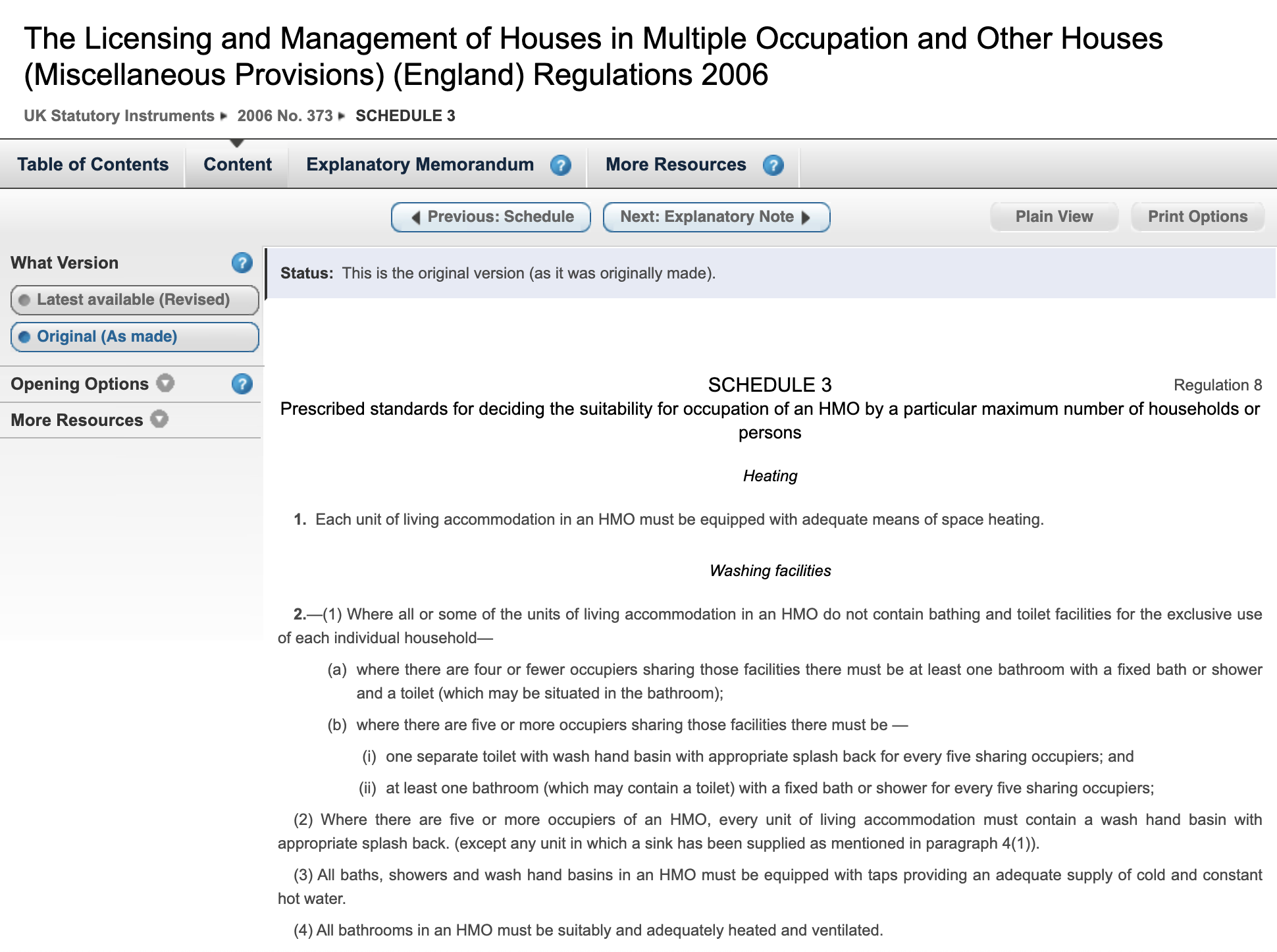If you’re an HMO landlord or are thinking about investing in HMOs, one thing you need to be aware of are the regulations surrounding HMO licences.
Failing to have the right licence in place can be a costly mistake to make, and potentially harm your ability to own and operate HMOs in the future.
In this post, we’ll be making sure you have all the information you need to stay on the right side of the law when it comes to HMO licensing.
We’ll be covering:
So let’s get started.
What is a mandatory HMO Licence?
A mandatory HMO licence is required by law for any HMO property that meets the relevant criteria set by the UK government.
It is a way of ensuring that all applicable HMOs provide an adequate level of accommodation for the tenants, and that the HMO is managed effectively on an ongoing basis.
This is achieved by providing standards that the accommodation must meet (set at both a national and local level – make sure you check both!), confirmed by an inspection by your relevant local authority, and by ensuring the person(s) or business responsible for managing the HMO has adequate systems in place to ensure the effective management, and is considered fit and proper (no criminal record or previous breaches of landlord licensing requirements).
Basically, mandatory HMO licensing exists as a way to ensure the standard of accommodation provided to tenants living in an HMO meets defined minimum requirements, and that the property and tenants will continue to be looked after by whoever is responsible for managing it.
It is a legal requirement to apply for and be granted a mandatory licence if your property meets the qualifying criteria.
Failure to do so can result in an unlimited fine, and cause you issues in future when applying for further HMO licences.
A valid licence is usually granted for 5 years following a successful application, but it can be for a shorter period of time if decided to be appropriate by the local housing authority who grants the licences for your area.
Do You Need a Mandatory HMO Licence for your rental property?
To work out if you need a mandatory licence, you’ll first need to establish whether your rental property is an HMO.
An HMO (in the most general sense), is any property that meets the following criteria:
- It is rented to three or more people who form two or more separate households
- There are some shared facilities within the property (e.g. toilet, bathroom and/or kitchen)
So that’s the definition of an HMO, but not all HMOs require a mandatory licence.
Mandatory HMO licensing only applies to HMOs with 5 or more tenants, meaning HMOs with 3 or 4 tenants do not need to apply for a mandatory licence (however they may still need another kind of licence depending on the area the property is located in – we’ll cover this shortly).
Does your HMO have 5 or more tenants?
If so, a mandatory HMO licence is a legal requirement.
The difference between HMO licensing and planning permission
One subject that often trips up new and aspiring HMO investors is the difference between planning permission that might be required for your HMO, and licensing requirements for HMOs.
This isn’t helped by the lack of cohesion between the different definitions of HMOs provided by the government – with various answers available depending on whether you’re looking at it from a licensing perspective or a planning perspective.
You can read more about the different HMO definitions in our Ultimate Guide to HMO Investing in the UK, but the main thing to note here to avoid confusion when talking about HMO licensing is that the two (licensing and planning) are very different, and shouldn’t be confused.
Mandatory HMO licensing applies to all HMOs with 5 or more tenants (as explained above).
Planning policy is relevant to all HMOs, regardless of size or number of occupants.
HMOs with up to 6 occupants are classed as C4 use class.
And HMOs with 7 or more occupants (among other things) come under the Sui Generis use class.
You can have the relevant planning permission for your HMO but be in breach of licensing requirements, or vice versa – and just because you do or don’t need one, doesn’t necessarily mean you do or don’t need the other.
Nice and simple… (you can thank central government for that)
What about additional licensing or selective licensing for HMOs?
Additional Licensing
The 2004 Housing Act introduced additional powers for local housing authorities, allowing them to expand licensing of HMOs to include smaller HMOs as well (HMOs with 3 or 4 tenants).
The local authority can apply additional licensing requirements to the entire district, or specific areas within it depending on where they see the need for it.
According to the relevant section of the housing act, the local housing authority “must consider that a significant proportion of the HMOs of that description in the area are being managed sufficiently ineffectively as to give rise, or to be likely to give rise, to one or more particular problems either for those occupying the HMOs or for members of the public”.
If your local authority has introduced additional licensing requirements, then it means that all HMOs within the designated areas will require a licence, regardless of the number of occupants.
The easiest way to check this is by doing a google search for “additional licensing <local housing authority>” (for example ‘additional licensing Stockport‘) to see what results come up.

Selective Licensing
Selective licensing is the third and final kind of licensing that can be applied to HMOs.
Like additional licensing, this gives the local housing authority the power to designate specific areas where they want to introduce a licensing scheme, however, with selective licensing there is no requirement for the property to be an HMO – the SLS (selective licensing scheme) will apply to all privately rented properties within the area.
This means that any private rented property (whether it’s an HMO or not) within a designated area will require a licence.
Again, this is outlined in the 2004 Housing Act, which sets criteria that must be met before the local authority can introduce a selective licensing scheme:
- ‘the area is, or is likely to become, an area of low housing demand’, and
- selective licensing could ‘contribute to the improvement of the social or economic conditions in the area’
or
- ‘the area is experiencing a significant and persistent problem caused by anti-social behaviour’;
- ‘that some or all of the private sector landlords who have let premises in the area (whether under leases or licences) are failing to take action to combat the problem that it would be appropriate for them to take; and
- selective licensing could ‘lead to a reduction in, or the elimination of, the problem’.
So the first thing to consider is whether or not your HMO will house 5 or more tenants. If it will, you must apply for a mandatory HMO licence.
One question we get asked a lot is ‘do I need a HMO licence for 3 tenants?’ or ‘does my 4 bedroom HMO require a licence?’.
If you are operating a ‘small HMO’ (defined, in this instance, as 3 or 4 tenants), then no mandatory licence is required but you will still need to check with your local housing authority to determine if they have introduced any additional or selective licensing schemes in the area.
Mandatory HMO Licences – The Requirements
As I mentioned earlier in this post, mandatory HMO licensing exists for two main reasons:
- To ensure an adequate standard of housing for the tenants
- To ensure the management of the property is carried out by a competent person or business
But what do these actually mean?
And how can you ensure your HMO is compliant so that your licence application becomes more of a box-ticking exercise than something to lose sleep over?
Let’s start with the standard of housing you’re providing.
The Housing Act 2004 specifies that for a licence to be granted, it must be “reasonably suitable for occupation by not more than the maximum number of households or persons“.
What does ‘reasonably suitable’ mean?
There is national guidance that is outlined here – The Licensing and Management of Houses in Multiple Occupation and Other Houses (Miscellaneous Provisions) (England) Regulations 2006.

Schedule 3 sets out the minimum national prescribed standards for HMOs, however these are very vague, and almost every local housing authority will have its own guidelines in addition to these, usually referred to as HMO Amenity Standards.
Again, a simple google search will provide the answer in most cases, or you can contact the housing department at your local authority to request a copy.

The guidelines set expected standards for the number, type, and quality of things like:
- minimum room sizes for bedrooms and communal space,
- kitchens, food storage and cooking facilities,
- toilets, bathrooms and showers,
- heating, ventilation and electrical installations.
These are usually described as the minimum acceptable standards, but I hope a lot of them seem almost inadequate to you if you’re creating a high-quality shared house.
For example, Lambeth council HMO amenity standards (and most others we have checked) require only one bathroom for every 5 occupants to meet the minimum standards.
Whereas our standard specification is to provide en-suite facilities in most bedrooms, making this specific requirement easy to exceed.
You can see some example amenity standard documents here:
How to apply for a HMO licence
The process for applying for a HMO licence can differ slightly in every local authority, but there are many similarities.
To make things easier, we’ve outlined the general steps on how to apply for an HMO licence with most local authorities. You can also find more detailed information about the application process for your own local authority at the GOV.UK website.
The Typical HMO Licence Application Process
- Complete Application
- Submit Supporting Documents
- Fee Payment
- House Inspection
- Make Any Required Improvements or Changes
- Receive HMO Licence
In most cases, you will need to fill out and submit an application form, which you can usually do online via the local authority’s website, or in person at the local authority offices.
The application form will ask for basic information about you and your property, as well as require you to declare that the property meets the minimum HMO standards set out by the government and your local authority.
It will also ask you to complete detailed information on the management arrangements for the HMO. This section can be completed by you, or by your letting agent if you’re using one. But keep in mind that it makes sense for the licence to be in your name (rather than your agent’s), as licences are not transferable and if you ever changed agent, you would need to reapply for a new licence.
You will also need to pay a fee, which can vary massively from around £300 at the lower end to over £1,000 with some local authorities.
Most will charge a single fee per property, however some local authorities charge based on the number of bedrooms, so larger houses will incur higher application fees.
You will also have to pay a renewal fee (usually less than the original application fee) every 5 years, or whenever the licence expires.
And along with the application, you may also be asked to provide additional documentation, such as:
- a measured floor plan of the property,
- electrical installation certificates,
- sample tenancy agreements,
- criminal background checks, etc
If you’re not sure what’s required, it’s always best to check with your local authority before making an application.
Once you’ve submitted your application, the local authority will carry out an inspection of the property to check that it meets the minimum standards.
If everything is in order, you will be granted a licence and will be able to start operating your HMO.
If there are any issues with the property, you will be given a list of improvements that need to be made before a licence can be granted.
And that’s it – you’re now ready to start operating your licensed HMO!
I appreciate that’s a lot of information to take in, but hopefully this post gives you a good overview of what you need to know about mandatory HMO licensing.
If there’s anything you’re still unsure about, let me know in the comments section below so we can help you out wherever possible.
Source link: https://www.insidepropertyinvesting.com/hmo-licences-everything-you-need-to-know/ by Inside Property Investing at www.insidepropertyinvesting.com






